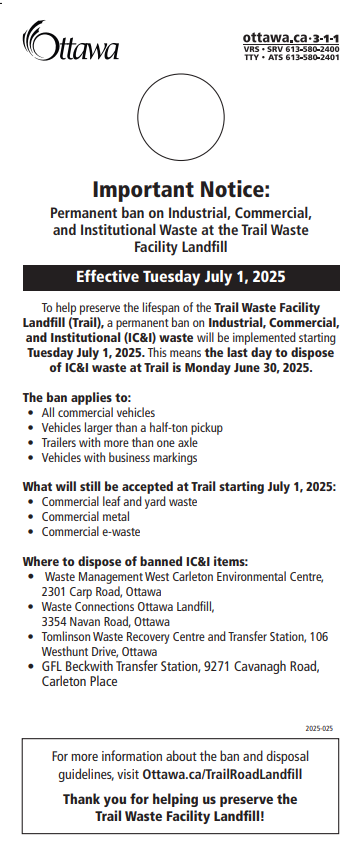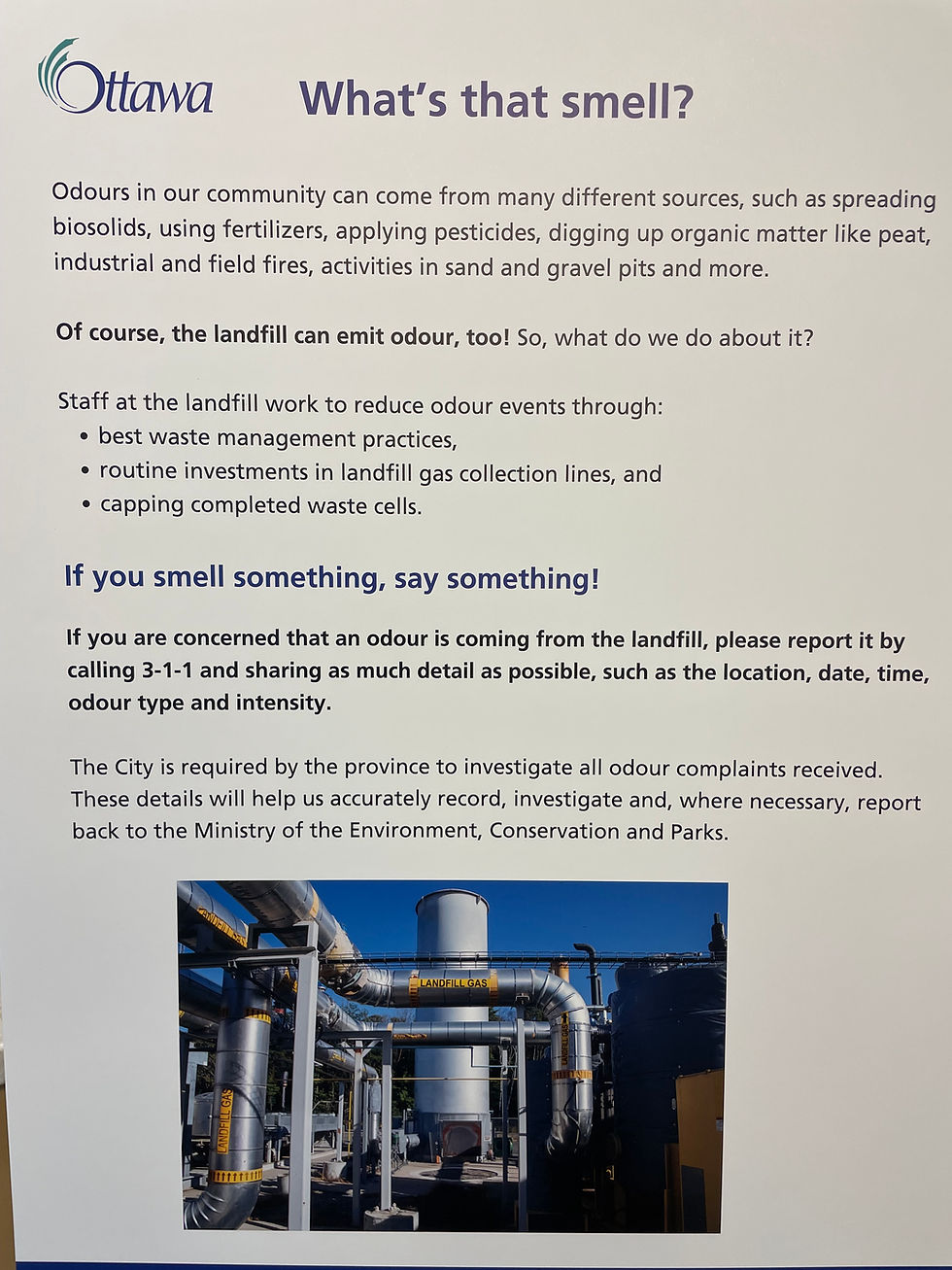Trail Waste Facility - Projects underway to improve the landfill
- Ward 3 Office

- May 20
- 6 min read
Updated: Sep 4
Information
The Trail Waste Facility is embarking some significant projects. An expansion to the landfill gas collection system is under way, and installation of the final cap a large portion of the landfill is underway.
Groundwater control investment (May 20, 2025)
The City of Ottawa is undertaking the installation of a row of three purge wells at the Trail Waste Facility to collect and convey groundwater through 2.1 kilometers long twin forcemains to the existing sanitary sewer system which will be conveyed to the ROPEC wastewater treatment facility for treatment. The objective of this project is to change the groundwater flow patterns to prevent offsite migration of groundwater contaminated from the Trail Waste Facility. The forcemain will be routed from the Trail Waste Facility, cross underneath Highway 416 and continue north on Borrisokane Road and end at the intersection of Cambrian and Elevation roads.
Design: March 2023 - February 2025
Construction start: spring 2025
Construction completion: spring 2026

Industrial, Commercial, and Institutional Waste Ban (May 13, 2025)

Trail Waste Facility optimization
The City is undertaking a project to optimize Trail Waste facility for managing the lifespan of the facility.
Gas collection investment (July 19, 2024)
The landfill has two gas collection systems, the Landfill Gas Perimeter Collection System (LGPCS), and the main Landfill Gas Collection System (LFGCS). The perimeter system was installed in 2018 along the eastern and southern and western boundaries of TWF. Overall landfill gas collection increased by 25% at that time, which represented a significant enhancement in odour control.
Since that time, significant additional improvements to the system are being made, including adding a substantial number of addition extraction wells on the waste mound to further increase our collection efficiency capabilities, and now installing additional temporary horizontal gas collection laterals to manage gas in areas which are not yet capped. Concurrent with this project, various components of the leachate collection system are being retrofitted to reduce the risk of acting as a conduit for landfill gas.
While the Landfill Gas Collection Expansion work is under way, construction will be conducted following these best management practices:
Trenches excavated to allow for collection infrastructure installation shall be kept to a minimum. Excavations will be limited to that which can be reasonably utilized in each day.
Open areas of trench are to be kept to a minimum at the end of each construction day.
All waste that is removed for trenching will be replaced as soon as possible. Any excess waste is to be deposited at the tipping face where it will be covered following best management practices.
Trenches shall be covered with a minimum of one metre of cover material.
Operation of the Existing Landfill and the Gas Destruction (Flare) System During Construction:
The existing gas collection system will continue to operate throughout the construction period as much as possible. Certain collection lines will not be operational during tie-in work where the new piping systems are connected to the existing infrastructure.
Flare downtime is not anticipated during this work but will be kept to a minimum if it is required and will be restarted as soon as it is possible.
Landfill cap system investment (July 19, 2024)
As a modern engineered landfill site, TWF caps landfill stages as they are completed with a polyethylene membrane final cover system. These caps are extremely important in reducing landfill gas emissions to the environment. Odours from the landfill are the result of landfill gas escaping from the waste mound. The gas is generated by the anaerobic decomposition of organic waste in the landfill producing methane, carbon dioxide and trace elements, which can be odorous. The bacteria breaking down the waste requires moisture to survive.
To reduce the amount of moisture entering the waste mound the City is required to install a final cover over completed sections of the landfill. Stage 1, which is in closest proximity to Barrhaven was capped in 2015 and 2016 (54 acres). Stage 2 was capped in phases between 2018 and 2021 (totaling 49 acres), Stage 3a was capped in 2021 (19 acres), and this summer we are capping Stage 3b and a portion of Stage 4 (20 acres).
The order of landfilling and capping was deliberately sequenced to progress away from the community over time. Typically, a stage is capped when it is filled to its entirety, however, the City is expediting the capping of a portion of Stage 4 as it gives us an opportunity to reduce the risk of odours migrating outside of the landfill. These capping projects not only reduce odours by removing moisture, but also improve the efficiency of our landfill collection infrastructure.
Reporting odour

Councillor's Comments
Trail waste open house follow up (August 22, 2024)
Meeting with General Manager of Public Works (July 26, 2024)
Barrhaven West Weekly Email (July 26, 2024)
I was fortunate to host the General Manager of Public Works here in Barrhaven last week. We talked about:
Grass maintenance issues: They are worse this year than in the past due to the heat and the significant rainfall this year. Also, with a significant rain event every 2-3 days, it not only causes faster growth, but reduces staff productivity because they can't mow in the rain and need to let it dry.
Chapman Mills weed maintenance: He is tracking the complication both of the technical ability to clear this area out, and also that the transition of maintenance responsibility has not gone well. He will get back to us with a strategy.
Jockvale Pedestrian Crossing: We are pleased that the new 99 OC Transpo bus route will enable safer bus usage for the residents of Steepleview housing, however, he has committed to working with us to address the issue of a proper pedestrian crossing site in the area of the Multi-use paths just South of the tracks.
Landfill Odor: Too many of us know the nasty smell that sometimes comes from the City Landfill. I have asked staff to hold a public meeting regarding this topic. Save the date for Wednesday, August 21st (2024) at 6pm for a public open house type meeting. It will be held at Trail Landfill, 4475 Trail Road.
Wild Parsnip: The City has expanded this year's wild parsnip application areas, targeting highly infested areas. Barrhaven roadside areas that were treated included Fallowfield, Borrisokane, Jockvale, Greenbank, Longfields Prince of Wales, and Bankfield along with numerous parks. The map and list for the specific areas of planned treatment, along with more information on the City's wild parsnip plan can be found here. We know that the wild parnsip goes well beyond the areas listed above, so if you see any especially bad areas that pose direct risk to safety (in parks, encroaching on walking/cycling pathways) please send us an email (david.hill@ottawa.ca) and we'll do our best, in collaboration to public works, to get it dealt with.
Inquiry to staff - reducing construction waste at Trail Waste Landfill (May 21, 2024)
Summary of response (full response in file below): staff responded that a waste audit is underway to look for ways to reduce waste going to Trail Waste Facility and that findings will be delivered in Q1 of 2025.
Inquiry to staff - total landfill waste by all producers (Nov. 21, 2023)
Summary of response (full response in file below): staff confirmed that they are working on methods to redirect some waste currently going to trail waste landfill.
Direction to staff - Landfill gas improvements at Trail Waste Facility (Nov. 21, 2023)
Summary of direction: for further clarity staff be directed to prioritize funding to only the following items: Landfill Gas Improvements at the Trail Road Waste Facility
Gas collection improvements (Nov. 17, 2023)
Recently, the Trail Waste Facility underwent an upgrade to the landfill gas collection system to improve gas collection efficiency. The process involves drilling vertical wells into the waste mound and installing gas collection pipelines called headers. Once commissioned, continuous suction is applied to the wells to draw out the gas and maximize gas collection efficiency. The landfill gas is combusted at the onsite power generation station which destroys the odours and produces enough power for approximately 6,000 homes. While the installation process can temporarily increase odours because it disturbs the waste, it has an overall net positive impact reducing ongoing odours.
.png)














